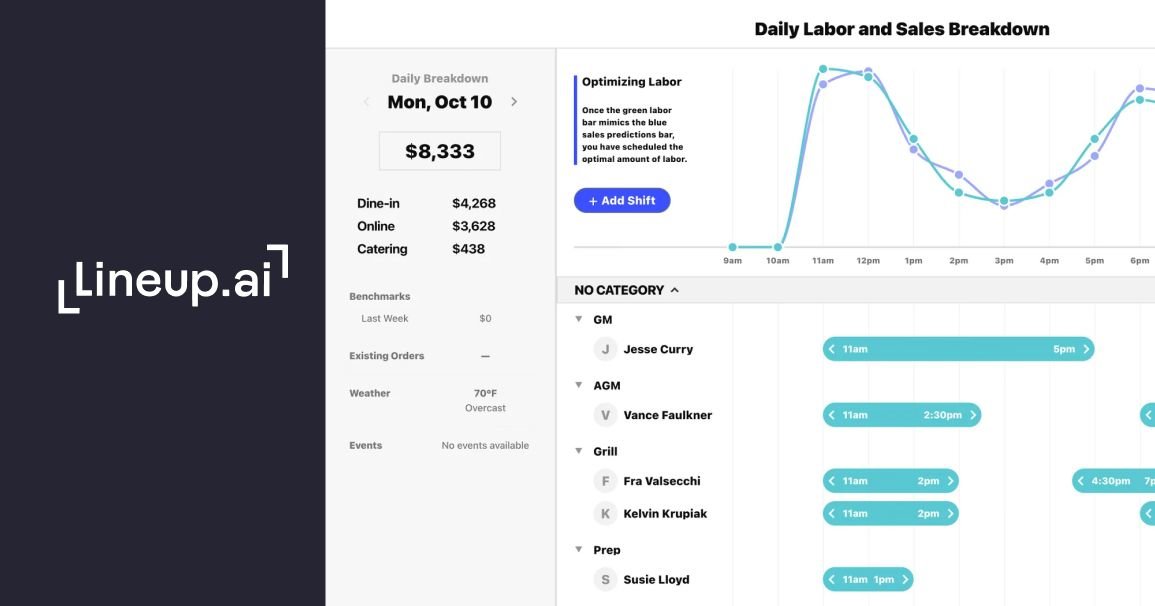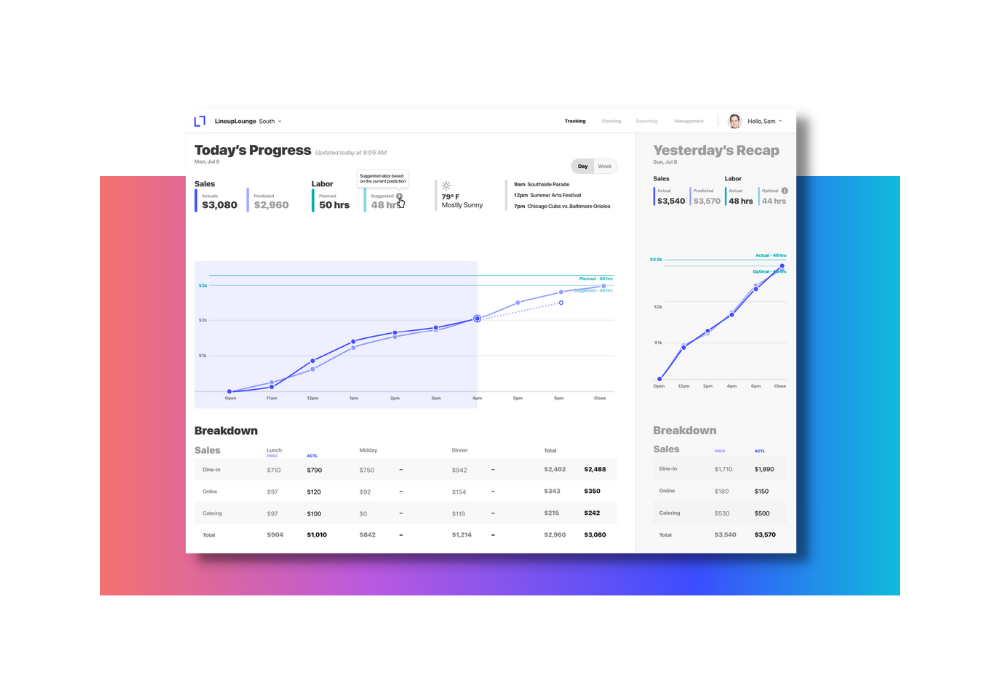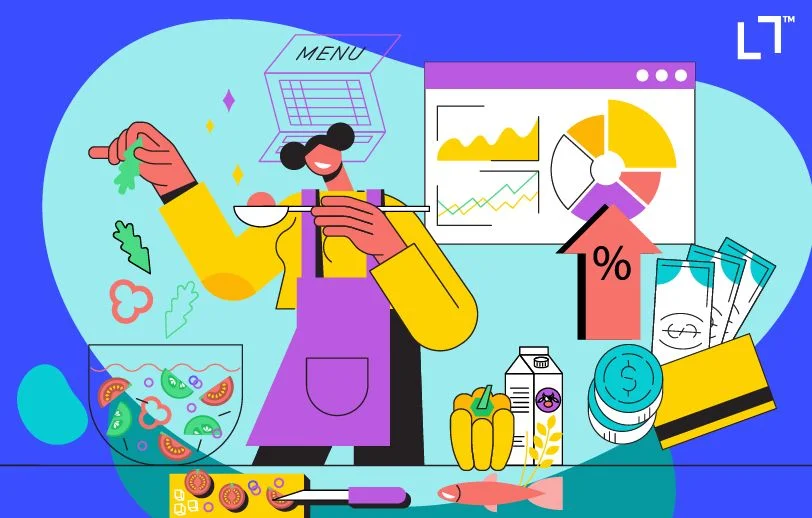They say data doesn’t lie. In the case of restaurant data analytics, data tells you everything you need to know to drive profits. The trick is learning how to use it. Leaders in the restaurant industry can’t afford to rely on guesswork and gut feelings to make decisions, so effective data analytics is a crucial practice.
Your restaurant's data is unbiased. Certain data points can tell you exactly what’s going on in key areas of your business, and indicate where your business needs the most attention.
Businesses who utilize data in their operations, marketing, and decision-making processes attract 26 times more customers compared to those who do not use data, and are19 times more likely to be profitable.
At the same time, gathering your restaurant analytics, and then using that data to draw insights and make business decisions can be harder than it sounds. There’s so much data available, and it’s not always obvious what it means or what it's telling you to do.
For example, imagine you look through sales data in your POS system and discover that sales are quickly dropping for one of your top menu items. It used to be popular, but now it’s barely moving. It's time to start searching for the cause. Is it a pricing issue? Has quality dropped? Are your marketing campaigns driving people towards a different option?
In this example, that single data point isn’t enough to diagnose the root cause. You need other information from areas like customer feedback and marketing audits to figure out what’s going on.
The ability to spot deeper issues from data is a powerful tool. You can leverage those insights to make better business decisions, optimize your operations, and ultimately make more money.
Let’s explore what it means to implement a data analytics strategy and how it can positively impact your restaurant business.
What are restaurant data analytics?
Restaurant data analytics refers to the process of collecting, analyzing, and interpreting data generated within a restaurant's operations to make informed business decisions and optimize various aspects of the restaurant's performance. This data can come from a variety of sources within the restaurant, including point-of-sale (POS) systems, customer feedback, reservation systems, inventory management, employee scheduling, and more
When we talk about restaurant data, we're looking at key data points that correlate to things like sales, food waste, review scores, frequency of repeat business, and how much of a restaurant's revenue is included in the profit margin. Basically, any pieces of verifiable information about your restaurant are viable metrics to use in your data analytics strategy.
There are plenty of things restaurant owners and workers notice throughout a given week or shift. It's not hard to tell when things are busy or if sales are lower, but analytics goes a step deeper. There have to be real, verifiable numbers attached so you can break them down and analyze them.
The difference between a real metric and a false data point is that metrics can be measured.
For example, say you're trying to measure the customer experience in your restaurant. Asking your team how they think customers feel might give you an idea of how things are going in general, but it's not a good data point. Intentional or not, unconscious biases and predispositions will play a role in what your team members notice.
A better way to measure customer experience is to use satisfaction surveys, look at online reviews, and compare those metrics to your rate of repeat business, average wait times, and table turnover.
Each of those pieces of information can be measured in a concrete way. They might not be perfect — surveys can easily be skewed by the way questions are asked or who you invite to respond — but even so, these methods give you a measurable benchmark to start with.
When you compare the more subjective metrics like ratings and reviews to your concrete data points like point of sale data, you can begin to see a clearer picture of how your restaurant operations are working.
In most businesses, we call these KPIs or key performance indicators. They are insights that tell us how business is doing and help us make better business decisions.
How to collect your restaurant's data
Collecting data for your restaurant involves gathering information from various sources within your establishment and possibly external sources as well. Just like any other statistic, your methods can skew your outcomes.
Here are steps to help you collect data for your restaurant.
1. Identify Data Sources
The sources of your restaurant analytics matter. Determine what types of data you want to collect. Common sources of data in a restaurant include:
- POS data
You can look in your POS system or expense tracking software to find real, accurate numbers. Collect data on sales volume, labor costs, menu items ordered, prices, and payment methods.
- Reservation system
If applicable, gather data on reservations, seating preferences, and customer information.
- Customer feedback
Other things aren’t as easy to measure, like the percentage of tables that come from repeat business, customer satisfaction ratings, quality of your dining experience, and average wait times during peak hours. A loyalty program can help you get much of this information in a less subjective way. As people scan their loyalty cards, you’ll have a better idea of the frequency and profitability of repeat business. Plus, you can leverage the program for other types of data collection to find out the impact of social media promotions, how many of your customers prefer online ordering, and more. For metrics around satisfaction, check ratings on sites like Yelp and Google.
- Inventory management
Use best inventory management software to track inventory levels, ingredient usage, and food wastage.
- Employee scheduling and performance
Record employee schedules, attendance, and performance metrics using time and attendance tracking and restaurant scheduling software.
- Customer demographics
If possible, gather data on customer demographics, such as age, gender, location, and dining frequency by using customer relationship management (CRM) software.
- External data
Consider external data sources like local weather conditions, events in your area, or market trends that may impact your restaurant. Lineup.ai is an automated tool for restaurants that uses AI to help restaurateurs predict sales, demand and labor for the upcoming period, while combining external factors like weather, local events etc.
The data you need depends on the question you’re trying to answer. If you want to increase revenue, for instance, you need to look at your financial data (like profit margins on menu items) plus metrics that tell you about how customers interact with your restaurant. Start broad, then narrow it down to the pieces of information that give you the most actionable insights.
There are multiple ways to get some of the trickier data points, but look for solutions that can give you the most objective and complete information possible.

2. Train Staff
- Ensure your staff is trained on data collection procedures and understands the importance of accurate data entry.
- Emphasize the importance of data privacy and security to protect customer information.
3. Maintain Data Quality
- Regularly review and clean your data to remove errors and inconsistencies.
- Ensure that data is entered accurately and consistently across all sources.
4. Secure Data
How to use your restaurant data analytics to increase profitability
Restaurant reporting should be used for both long and short-term analytics. Your data dashboards can tell you about restaurant sales performance, give you valuable business intelligence, and help with wise decision-making at every level.
It does require strategy and intention, so it helps to make sure you're looking at the right data. Once you've collected your restaurant data, here are some tips for taking an in-depth look at all your data and using it to make informed decisions.
1. Forecast better
Forecasting is one of the most important data-related practices in the restaurant industry. So much decision-making that affects profits comes down to planning ahead, and the only way to plan ahead is through reliable forecasts. You need forecasting that is data-driven and accurate to make predictions about your staffing and supply needs.
You should be using forecasting to make expense-related decisions like ordering inventory, staffing, and marketing. Restaurant owners rely on accurate forecasting to stay in business.
Your restaurant data is the key. Take into account previous sales on similar days during similar seasons, weather predictions, local events, and any other relevant data you can access to come up with the most accurate forecasts.
One of the best ways to leverage this information is with AI and machine learning-assisted tools. Forecasts take a lot of information to do well, and it’s difficult and time-consuming to collect all of that data into a spreadsheet to analyze. Furthermore, not everyone at your restaurant has the skills and practice, so implementing technology provides everyone with the ability to forecast.
Instead of trying to forecast manually, use a specialized forecasting tool like Lineup.ai that collects and analyzes that information for you to come up with more accurate forecasts based on real-time information. Learn more about Lineup's features.

2. Order more accurately and reduce food waste
Data in your POS system can often tell you a surprising amount of information. Some POS systems can tell you what ingredients get added on the most and when, what dishes do best at specific times, and peven which items have the most remakes and errors.
You might not think you need that level of detail, it can be extremely helpful for ordering inventory, reducing waste, and avoiding selling out of key items. You should at least have the ability to track what ingredients and menu items are contributing to the most spoilage and waste.
Your forecast will help you cut back on food waste as you do your regular ordering, but use your data to go deeper into the issue.
What menu items should you consider changing? What should you add? Do different customer demographics tend to order different foods? Can you change your marketing strategy to attract more profitable customers?
There are layers of business intelligence here that can make a huge difference in monetary loss due to food waste. Use your restaurant analytics to help you find all the root causes of inventory loss and waste, then track how those metrics change as you implement new strategies to address them.
Consider using a tool like Lineup.ai for item-level forecasting. Similar to sales and labor forecasting, item-level forecasts give you the ability to plan ahead in order to extend profit margins. Lineup.ai can help you predict how many of each item you'll sell on a given day down to the hour. It shows you how the previous week's forecasts measured up to actual sales, and tells you how much of each item to prepare to avoid food waste and selling out.
3. Encourage repeat business
Earlier, we talked about the data collection benefits of a loyalty program. Now, let’s look at some of the ways your loyalty program and the associated data can help you increase repeat business and improve your profit margins when those people come back.
Data in your loyalty program can tell you a lot about your most profitable restaurant guests. You can see some basic information about their demographics, the days and times they are most likely to visit, and what they order the most. Depending on the POS you use, you might also have a history of satisfaction ratings and other qualitative data for your loyal visitors.
One smart strategy is to identify your most profitable repeat business and create a customer profile from that data set.
Let’s say your most lucrative customers tend to be adults who usually order food for another adult and two children, making it likely that these are people coming in as a family. You notice that these tables tend to order appetizers and desserts more frequently than other visitors, and while they’re not the biggest drinkers, they often get a couple of drinks. They come in fairly early on weeknights, usually towards the end of the week, and they stay a little longer than other customers.
Knowing this, you can make a lot of strategic decisions. You might focus your marketing to appeal to families, or perhaps you expand your appetizer menu to include more kid-friendly finger foods with high-profit margins.
By tweaking your menu, your marketing, and even your service strategy or table layout, you can increase the percentage of these types of customers that come back again and again.
It’s also a good idea to target your most profitable customers with special offers directly through your loyalty program. This strategy can be tailored to work with individual data, too. For instance, you might send out an extended happy hour offer to people who usually come in for your weeknight specials.
4. Reduce staffing costs and hassle
Labor costs are already a huge part of your overhead, and they're continuing to rise across the country. It’s in your best interest to staff wisely and reduce staffing costs, but you need to make sure you're not sacrificing customer service or alienating employees in an already competitive job market.
Again, your data-driven forecast is one of the most valuable uses of restaurant analytics here. By accurately predicting business needs and scheduling the right people on the right shifts, you can drastically reduce problems with over- or understaffing.
That’s great for your service levels, plus it helps reduce internal conflict between staff members. When you can more easily manage who gets scheduled for the most profitable shifts, it’s easier to do the people management side of restaurant leadership.
How do you determine who the “right” person is for the most demanding shifts? You guessed it — restaurant data analytics.
Your POS can give you a lot of insight into who can handle the most tables at the same time, who is the best at upselling, and who might need a little more training before taking on the weekend dinner rush.
As an added benefit, this information can help dramatically reduce restaurant employee turnover. Since your best staff members will get the most profitable shifts regularly, they will make more money and be more likely to stay. Plus everyone will appreciate being more thoughtfully scheduled to reduce problems with under- and overstaffing.
The bottom line
These specific examples show you some of the most impactful ways that data can help you make more money in your restaurant.
But these are definitely not the only applications of your restaurant data analytics. There is no limit to the types of improvements you can make when you’re informed by real data. Consider using data to:
- Improve your dining experience
- Increase operational efficiencies to make your employees’ jobs easier
- Optimize your budget
- Implement or improve your carryout and delivery systems
- Shift your marketing away from discounts without losing effectiveness
- Speed table turnover
- Make your menu more profitable
- And more
Whenever you have a specific business goal, it’s good practice to consider how to use concrete data to inform those decisions. After all, making informed choices is always more likely to succeed.
Further read:

Boris Mustapic is a content marketer with a decade of experience in the digital marketing industry. He specializes in helping B2B SaaS companies drive growth through strategic, product-led content marketing.
More about the author